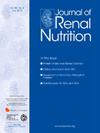Higher Dietary Inflammatory Index and Systemic Immune-Inflammation Index Score are Associated With Higher Risk of Chronic Kidney Disease: Analysis of the National Health and Nutrition Examination Survey From 1999 to 2018
IF 3.2
3区 医学
Q2 NUTRITION & DIETETICS
引用次数: 0
Abstract
Objective
Chronic kidney disease (CKD) is characterized by a gradual decline in kidney function over time. The role of dietary inflammatory index (DII) and systemic immune-inflammation index (SII) in individuals with CKD remains uncertain. We aimed to explore the potential correlation between DII and SII with the prevalence of CKD in adult Americans.
Methods
This cross-sectional study used data from the National Health and Nutrition Examination Study between 1999 and 2018. The DII was calculated based on the 24-hour dietary history interview, while the SII was calculated as the product of platelet count multiplied by neutrophil count and divided by lymphocyte count. CKD was diagnosed based on impaired glomerular filtration rate (<60 mL/min per 1.73 m2) or urinary albumin-creatinine ratio ≥30 mg/g. Multivariable logistic regression analyses and subgroup analyses were performed to examine the association between DII/SII and CKD.
Results
In total, this study included 40,388 participants, of whom 7443 (18.4%) had CKD. The prevalence of CKD changed from 14.84% (95% confidence interval (CI): 13.20-16.48%) in 1999-2000 to 12.76% (95% CI: 11.10-14.43%) in 2017-2018. According to adjusted multivariate logistic regression models, individuals with higher DII scores had a higher likelihood of having CKD (odds ratio = 1.24; 95% CI: 1.12-1.37). Similarly, higher SII scores were associated with a higher risk of CKD (odds ratio = 1.37; 95% CI: 1.25-1.50). Subgroup analyses further demonstrated relatively stronger associations between DII/SII and CKD among individuals with other factors such as sex, age, body mass index, smoking status, drinking status, hypertension, and diabetes.
Conclusions
The DII and SII scores were significantly positively associated with higher risks of CKD. Anti-inflammatory diet might have the potential to prevent CKD. The SII may serve as a cost-effective and straightforward approach for detecting CKD. Further prospective longitudinal studies are needed to verify the causality.
较高的膳食炎症指数和全身免疫炎症指数得分与较高的慢性肾病风险有关:1999年至2018年全国健康与营养调查分析》。
目的:慢性肾脏病(CKD)的特点是肾功能随着时间的推移逐渐下降。膳食炎症潜能对全身炎症的影响已得到公认,但有关膳食炎症指数(DII)与慢性肾脏病之间关系的研究却很有限。虽然炎症与肾脏损伤有关,但全身免疫炎症指数(SII)在慢性肾脏病患者中的作用仍不确定。因此,本研究旨在探讨 DII 和 SII 与美国成年人慢性肾脏病患病率之间的潜在相关性:这项横断面研究使用了 1999 年至 2018 年期间美国国家健康与营养调查研究(NHANES)的数据。DII根据24小时饮食史访谈计算,SII则根据血小板计数乘以中性粒细胞计数再除以淋巴细胞计数的乘积计算。肾小球滤过率受损(< 60 ml/min per 1.73 m2)或尿白蛋白-肌酐比值(UACR)≥30 mg/g,即可诊断为慢性肾脏病。研究人员进行了多变量逻辑回归分析和亚组分析,以检验 DII/SII 与 CKD 之间的关联:本研究共纳入 40388 名参与者,其中 7443 人(18.4%)被诊断为 CKD。CKD患病率从1999-2000年的14.84%(95% CI:13.20%至16.48%)变为2017-2018年的12.76%(95% CI:11.10%至14.43%)。根据调整后的多元 Logistic 回归模型,DII 分数越高的人患 CKD 的可能性越大(OR = 1.24;95% CI:1.12-1.37)。同样,逻辑回归分析证实,SII 分数越高,患 CKD 的风险越高(OR = 1.37;95% CI:1.25-1.50)。亚组分析进一步表明,在性别、年龄、体重指数、吸烟状况、饮酒状况、高血压和糖尿病等其他因素的个体中,DII/SII 与 CKD 的关联性相对更强:结论:DII 和 SII 评分与较高的 CKD 风险呈显著正相关。抗炎饮食可能具有预防慢性肾脏病的潜力。SII 可作为检测慢性肾脏病的一种经济、直接的方法。需要进一步的前瞻性纵向研究来验证其因果关系。
本文章由计算机程序翻译,如有差异,请以英文原文为准。
求助全文
约1分钟内获得全文
求助全文
来源期刊

Journal of Renal Nutrition
医学-泌尿学与肾脏学
CiteScore
5.70
自引率
12.50%
发文量
146
审稿时长
6.7 weeks
期刊介绍:
The Journal of Renal Nutrition is devoted exclusively to renal nutrition science and renal dietetics. Its content is appropriate for nutritionists, physicians and researchers working in nephrology. Each issue contains a state-of-the-art review, original research, articles on the clinical management and education of patients, a current literature review, and nutritional analysis of food products that have clinical relevance.
 求助内容:
求助内容: 应助结果提醒方式:
应助结果提醒方式:


